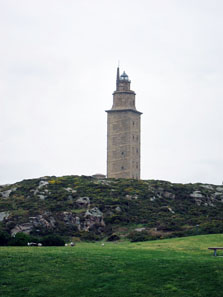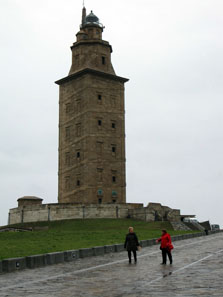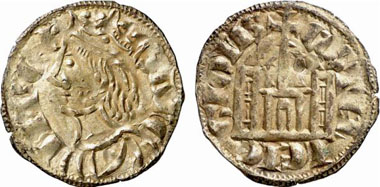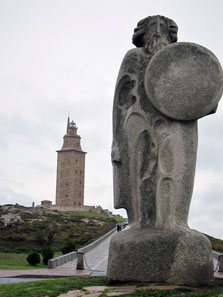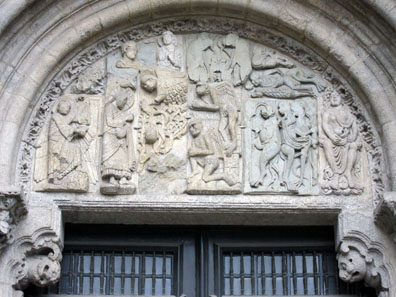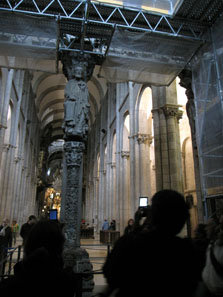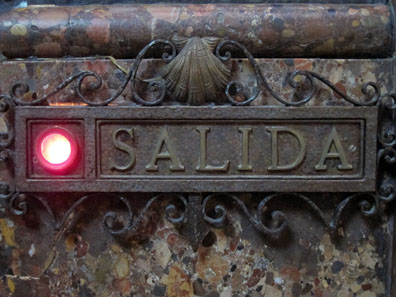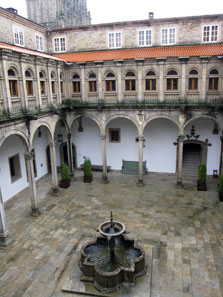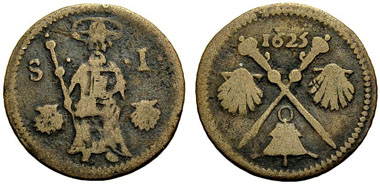by Ursula Kampmann
August 16, 2012 – Santiago! Saint James de Compostela! The last few years have seen an incredible renaissance in people making pilgrimages to him. Despite this surge in popularity, we were quite happy to be making our way towards him by car and not by foot, since this meant we could easily make a quick detour to A Coruña to see the last remaining Roman lighthouse.
Wednesday April 11, 2012
It wasn’t so foggy that we couldn’t see the lighthouse, but when we woke up it was raining so hard that it was almost like a river pouring from the sky. It rained as we set off from Vilalba, it rained throughout the entire trip to A Coruña, it rained as we drove through the city, cursing, since the road signs were slightly misleading, and it was still raining by the time we found the parking lot from which you can gaze in amazement at one of the great wonders of the Roman world: the only existing lighthouse from Roman times.
The Lighthouse of A Coruña. Photo: KW.
Adobicum Curonium, likely founded by the Phoenicians, was an extremely important port for the Romans even long before the time of Augustus. They had settled here as early as the 2nd century BC to ship pewter that was mined in Galicia. Standing guard over the port was the famous lighthouse, whose exact date of origin still hasn’t been conclusively established. Julius Caesar, who was pro-praetor of Spain at the time, is said to have visited the city in 62 BC.
Trajan, AE-Hemidrachm, 107/8. Rv. Pharos. From Auction Dr. Busso Peus Nachf. 406 (2012), 604.
The lighthouse may have been a simple tower during Roman times, where material for burning was brought by stairs to the uppermost platform. There, it would have been set alight to help the ships along the dangerous coast find the port entrance.
The Remains of the Fortification around the Lighthouse. Photo: KW.
Mass migration and incursions by the Normans drove the city’s residents into the country’s interior. During the Early Middle Ages, A Coruña was nothing more than a small, insignificant fishing village, but this all changed in the 11th century, when the still well-preserved ruins of the lighthouse were integrated into a fortress that could be used against the Vikings. In order to uphold this fortress, the rights to it were granted to the Bishop of Santiago, who had his own plans for the city…
Sancho IV. of Castille and Leon, 1284-1295. Cornado, Coruña. Bust of the King l. Rv. Fort Castle between Star and Shell. From Künker Auction 137 (2008), 3435.
Alfonso IX bestowed a number of privileges on Coruña, which had by now developed considerably – he granted it the privilege of disembarking and selling salt, and a royal mint was built there, despite the fact that Johann of Castille had only conferred the rights of a city to the settlement in 1446. At that time, A Coruña was the point that pilgrims from the British Isles, the Netherlands and Flanders, Northern Germany, Poland and the Baltics arrived at by ship before continuing their pilgrimage onto Santiago.
1809 Medal of the Death of General John Moore before A Coruña. Münzen und Medaillen 24 (2007), 1160.
World history was written here yet again in the Early Modern Age, when the Spanish Armada gathered here to begin their 1588 invasion of England. This, incidentally, turned out to have dire consequences for A Coruña – one year later, Francis Drake and the English fleet appeared before the city walls to lay waste to the city from the sea.
There was another battle for A Coruña during the Napoleonic Wars. Sir John Moore died at this battle, but not before learning that the battle had actually been won. His last words are said to have been, ‘I hope that the people of England will be satisfied! I hope that my country will give me my due.’ He was, at the very least, given a statue in St. Paul’s Cathedral in London for his committed service.
Breoghan the Irishman – Founding Father according to Celtic Myth. Photo: KW.
Battling the rain and wind, we made it to the lighthouse, which is surrounded by a lovely sculpture park. One of the sculptures is of Breoghan, a seafarer from Celtic mythology. It’s said that he built a tower (the lighthouse) in Brigantium (the ancient Coruña) of such a great height that it served as a landmark when he made the move to invade and conquer Ireland and settle there with his Celts.
The Parador of Santiago Looks Much Prettier When It’s Sunny. Photo: KW.
It was still raining as we set off again, and showed no signs of letting up about half an hour later either as we, extremely frustrated, tried to find the way to the Parador in Santiago – the road signs in Spain are distributed so parsimoniously that you can be sure there won’t be one where you need one. It continued to rain as the elegant concierge drove our car into the hotel garage and a bellboy in a green uniform arrived to take us to our room.
The Pilgrimage Church of Santiago – in the Rain. Photo: KW.
One shouldn’t really complain about the rain. What we should have done, of course, is read the various guidebook commentaries a little more carefully before coming, like, for instance, this remark by Dietrich Höllhuber and Werner Schäfke in the cultural guidebook by Dumont: ‘It rains a lot in Santiago de Compostela. Tourists with plastic bags on their heads bolt from one arcade to another and gaze longingly at the locals with their trusty umbrellas.’
Well, at least we didn’t do that! We stood under our tiny, elegant umbrella that, admittedly, we had only bought on the way to our second last parador. The square in front of the Cathedral of Santiago de Compostela wasn’t that crowded, just a few pilgrims who were having their picture taken at the official zero-kilometer mark of the pilgrim’s path in front of the church, a few tourists under umbrellas, bravely battling the rain, and us.
Portada de Platerias. Photo: KW.
Do we really have to tell the story of Santiago again? Ok, here goes, in point form: Saint James proselytizes in Spain; sustains a martyr’s death in the Holy Land; his body is taken by boat directly to Padrón; it’s then taken to Santiago and forgotten; in the 9th century, a hermit has an intuition; brings the tomb to the attention of the bishop; the first church construction under Alfonso the Chaste (791-842); it’s useful as a focal point of the Reconquista and as argument for the fact that the secular and ecclesiastical status of Spain should be raised.
Friedrich Ulrich of Brunswick-Wolfenbüttel, 1613-1634. Rv. Saint James in front of the mine of Saint James. From Künker Auction 201 (2012), 550.
In short: on the recommendation of the Spanish King and the French Abbey of Cluny (which was recruiting crusaders for the liberation of Spain from among the aristocracy) Santiago becomes one of the most admired saints of the Middle Ages, especially once Jerusalem is once again take from the Christians and Saint James has only Rome to contend with in terms of pilgrims.
The Saint James Pilgrims had such an influence on the Middle Ages that it soon became impossible to even think of Saint James in anything other than pilgrim’s garb – a wide-brimmed hat to shield the rain (you know why!), a thick coat of warm cloth over the shoulders, with shells sewed on as a pilgrim’s badge, and a long cane in the left hand, used not only for support but also to fend off dogs and bandits.
Detail from a Saint James Statue in the Cathedral Museum of Burgos. Photo: KW.
And don’t forget the water bottle (once you’ve crossed the lowlands between Burgos and Leon, you’ll understand why) and the pilgrim’s bag, also adorned with shells.
Pórtico de la Gloria, Surrounded by Scaffolding. Photo: KW.
The first way led us, of course, to Santiago. I was like a giddy, excited kid, waiting for the big moment when I’d get to see the formidable Porta Gloriae. They’re the most beautiful Romanesque entrance gates I’ve ever seen. In the middle, Saint James enthroned, surrounded by evangelists and prophets, and above, Christ in Majesty. When I went in, I was shocked to find everything scaffolded! Now I understand, of course, that even this portico has to undergo restoration at some point, but between the crummy weather, the chaos trying to get to the damn parador and now this… well, let’s just say I’d had it with Santiago!
Lights to Control the Hordes of Visitors. Photo: KW.
The scene inside didn’t exactly capture the same degree of devotion and transcendence that a medieval pilgrim’s guide may have required of those viewing the structure: a child was screaming, a couple of tour groups were very loudly pointing out the various attractions and thousands of flashes were going off in the nave (despite the ‘no photography allowed’ sign). I have to admit that at that moment I was pretty happy that I hadn’t made a many hundreds of kilometers-long pilgrimage here only to be confronted by these throngs of people.
The Baroque High Altar. Photo: KW.
It only seemed fitting that we also follow the route outlined for the pilgrims. We went down to James’ holy shrine (and refrained from taking a photo because of a giant sign which asked for reverence before the holy site, but we were the only ones doing so). We also looked at the bust of Saint James in the altar (but without embracing it, as instructed) and then wandered through the church with its interesting mix of Romanesque, Gothic and Baroque styles.
We had wanted to go into the cathedral museum, but since they were closing in an hour they weren’t allowing anyone else in. So instead we made our way back out into the pouring rain to walk for a bit, which didn’t turn out to be the most appealing alternative. We decided to go get something to eat, and afterwards it was still raining. We then decided to take a little afternoon nap, and what do you know – it rained still more!
A Look at One of the Inner Courtyards of the Parador. Photo: KW.
We then took an indoor tour of our parador, the Hostal de los Reyes Católicos, which is one of the country’s best known. The structure dates back to the late Middle Ages and was raised in the same year that Granada was conquered and Christopher Columbus set out on his voyage to the New World. It was endowed in 1492 by the Catholic Queen Isabella of Castille and Ferdinand of Aragon in order to provide pilgrims with food, lodging and a bit of a respite before making the voyage back home. Even today, it’s said that 30 pilgrims are allowed to eat at this posh hotel every day.
The structure is quite large, comprising four courtyards that are named after the four evangelists. There’s also a magnificent chapel, the inside of which was already set up for a dinner for a large group. At some point though, despite the parador’s size and grandeur, there was really nothing more to see, so we headed back out into the rain.
Paris. Copper Stamp of the Church of Saint James from 1625. From Münzen und Medaillen Auction 32 (2010), 624.
Facing the rain head-on, we went over to the museum, only to be told by the guard that they’d be closing in an hour and that we couldn’t go in! To be honest, after all this Santiago won’t exactly stand out in my mind as my favourite city!
What else is there to tell? Oh yes, we did find a very charming shop where we bought a very large and stable umbrella. Mind you, now that we were so well prepared, the weather would probably be better the next day…
I can assure you, it did indeed get better. And in the next chapter I’ll be showing you Vigo, where, in 1702, the English captured silver valued at 1,500,000 pounds sterling, a portion of which they stamped into coins.
You can read all other parts of this diary here.



